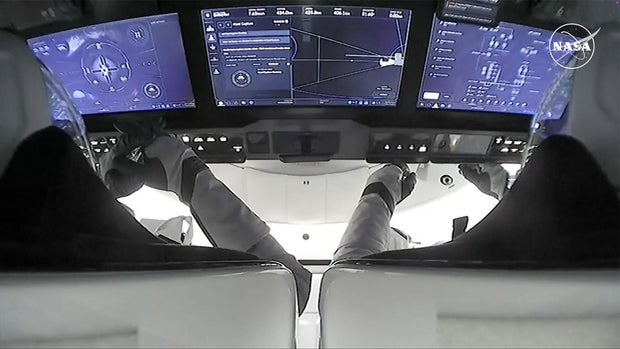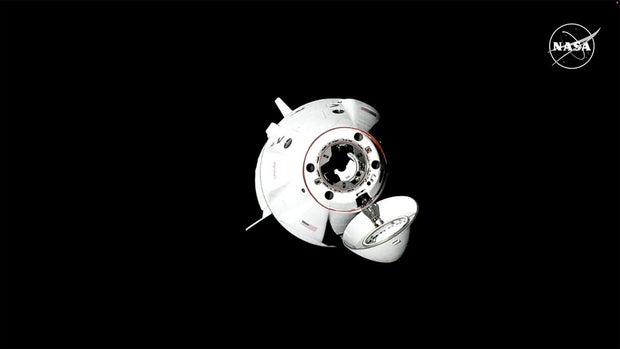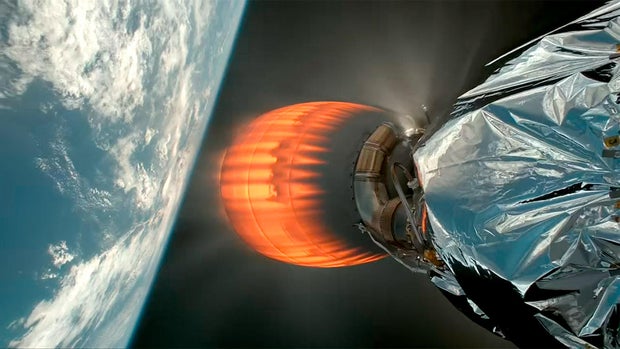A day after launch from Kennedy Space Center, a SpaceX Crew Dragon spacecraft overtook the International Space Station and departed to dock Sunday, bringing a NASA astronaut and a Russian cosmonaut to the outpost to spend five months at two Starliner astronauts. conscription.
The rendezvous took place after SpaceX learned it has suspended Falcon 9 launches while engineers try to figure out what caused the Falcon 9 crew upper stage to fail on Saturday after the Crew Dragon was released to fly on its own to fly, resulting in an off-target re-entry over the Pacific Ocean.
Sen
SpaceX said in a post on social media platform X that the second stage “experienced an off-nominal deorbit burn. As a result, the second stage landed safely in the ocean, but outside the intended area. We will resume the launch after we better understand the cause.”
It was the second anomaly in the Falcon 9 upper stage in less than three months and the third landing accident failure in the first stage. It is not yet known what impact the latest problem could have on downstream flights, including two high-priority launches in October to send probes from NASA and the European Space Agency on trips to Jupiter and an asteroid.
But the anomaly did not affect the Crew Dragon’s 28-hour rendezvous with the space station, and the ferry ship, carrying Commander Nick Haag and cosmonaut Alexander Gorbunov, docked at the laboratory’s outer port at 5:30 p.m. EDT while the two spacecraft took off. 425 miles above southern Africa.
Starliner commander Barry “Butch” Wilmore and pilot Sunita Williams, who now serves as the space station commander, were on hand to welcome The Hague and Gorbunov aboard, along with Soyuz MS-26/72S commander Aleksey Ovchinin, Ivan Vagner and NASA astronaut Don Pettit.
Hague, Gorbunov, Wilmore and Williams will replace Crew 8 commander Matthew Dominick, Mike Barratt, Jeanette Epps and cosmonaut Alexander Grebenkin when they return to Earth around October 7 to complete a 217-day stay in space.
Wilmore and Williams took off on the first piloted test flight of the Starliner, a mission expected to last just over a week, on June 5. During an rendezvous with the space station the day after launch, multiple helium leaks were detected in the ship’s propulsion system and five maneuver aircraft malfunctioned.
SpaceX/NASA
NASA and Boeing spent the next three months conducting tests and analysis to determine whether the Starliner could safely return its crew to Earth. Ultimately, NASA managers decided to keep Wilmore and Williams on board the station and to shoot down the crewless Starliner.
They made that decision knowing the two astronauts could come home aboard the Crew Dragon that launched Saturday. Two astronauts from Crew 9 – Zena Cardman and Stephanie Wilson – were removed from the crew to provide seating for Wilmore and Williams when Hague and Gorbunov returned to Earth in February.
When they finally get home, Wilmore and Williams will have logged 262 days in space, compared to five months for Haag and Gorbunov.
The Crew 9 flight was SpaceX’s 95th launch so far this year. And it was the company’s third flight in less than three months to experience problems.
NASA
SpaceX recovers, refurbishes and relaunches Falcon 9 first-stage boosters, which can land in California, Florida or aboard offshore droneships. The second phases are not restored.
Instead, SpaceX orders the upper stage engines to fire to propel the stages back into the atmosphere for a destructive rupture, ensuring that all debris falls into the ocean, far away from shipping lanes or populated areas. areas.
By deorbiting the Falcon 9 upper stages after their missions, SpaceX ensures they will never pose a collision risk with other spacecraft or add to the space debris already in low Earth orbit.
During the launch of 20 Starlink Internet satellites on July 11, the Falcon 9s second stage defective and failed to complete a “burn” necessary to achieve proper orbit. All twenty satellites were stuck in a lower-than-planned orbit and fell back into the atmosphere and burned up.
SpaceX briefly suspended flights at the behest of the Federal Aviation Administration, but the problem was quickly identified and resolved, and the company was allowed to resume flights while the investigation continued.
Than, during another Starlink launch on August 28a Falcon 9 first stage descending to landing crashed on the deck of an offshore drone ship. SpaceX did not provide any information about what went wrong or what corrective action, if any, was needed, but flights resumed three days later.
SpaceX has not provided any details about the off-target re-entry of the Crew Dragon upper stage, other than its post late Saturday on X.
SpaceX
At Saturday’s launch, SpaceX planned to launch 20 OneWeb broadband satellites this week from Vandenberg Space Force Base in California, followed by a Starlink launch from Cape Canaveral. Both flights are now on hold.
More importantly, a Falcon 9 will be used to launch the European Space Agency’s $390 million Hera asteroid probe from the Cape Canaveral Space Force Station around October 7, followed by the launch of NASA’s Europa Clipper Jupiter probe of $5.2 billion from the Kennedy Space Center on October 7. 10.
Hera is headed for the asteroid Didymos and its moon Dimorphos, a small body that NASA’s DART probe collided with in 2022. Hera will study the system in detail to determine how the moon’s structure and orbit were changed by the impact. A primary goal is to learn more about how an Earth-threatening asteroid might one day be safely redirected.
The Europa Clipper is a ‘flagship’ mission to explore Jupiter’s ice-covered moon Europa and determine the habitability of a vast subsurface ocean. It is the largest planetary probe ever built and will require a powerful Falcon Heavy rocket, consisting of three Falcon 9 first stages strapped together and a single upper stage, to send it on its way.
Both missions must get off the ground during relatively short “planetary” launch windows determined by the positions of Earth, Mars, Jupiter and the asteroids. Hera’s window opens on October 7 and closes on October 25. The Europa Clipper launch window opens on October 10 and runs through November 6.
Missing a planetary window can result in long, costly delays while Earth, Jupiter, the asteroids and Mars needed for gravity-assisted flybys return to favorable orbital positions that allow launch.
Armando Piloto, senior manager at Kennedy Space Center’s Launch Services Program, said the Falcon Heavy stages used for the Europa Clipper mission will not be recovered. Instead, they will use up all their propellants to reach the speed needed to send the probe on a five-year journey to Jupiter.
“I would like to point out that during the burn of the second stage, the vehicle carrying the spacecraft will be traveling at approximately 40,000 kilometers per hour, which will be the fastest speed for a second Falcon stage ever for Europa Clipper,” he said during a recent briefing .
Given SpaceX’s rapid recovery from the failures in July and August, the upper stage re-entry anomaly will likely be resolved on Saturday in time to get the Europa Clipper and Hera missions off the ground within their launch windows. But that will depend on the results of the latest fault investigation.









